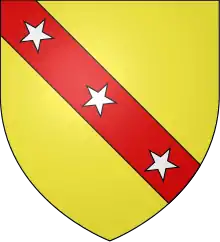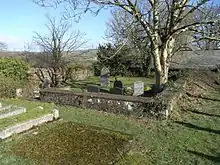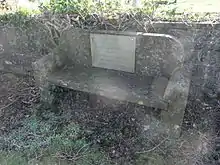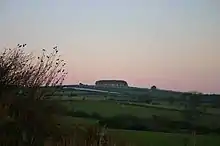George Wentworth Warwick Bampfylde, 4th Baron Poltimore
George Wentworth Warwick Bampfylde, 4th Baron Poltimore (1882–1965) (and 9th Baronet)[1] of Poltimore and North Molton, Devon, was a peer and major landowner in Devonshire, whose family had been seated at Poltimore from about 1300. He was a Justice of the Peace for Devon and occupied the honorary position of High Steward of South Molton, Devon.[1]

Origins
He was born on 23 September 1882, the eldest son and heir of Coplestone Richard George Warwick Bampfylde, 3rd Baron Poltimore (1859–1918) by his wife Hon. Margaret Harriet Beaumont (died 1931), daughter of Wentworth Blackett Beaumont, 1st Baron Allendale (1829–1907).[2]
Career
He was educated at Eton College and at New College, Oxford, where in 1910 he gained a half blue in polo winning 10–2 against Cambridge.[3] He served as Lieutenant in the Grenadier Guards. He fought in World War I and was twice mentioned in despatches. He served in the Quartermaster-General's staff and in the Lincolnshire Yeomanry and was a Major in the Royal North Devon Yeomanry. He served as a Justice of the Peace for Devon and held the honorary office of High Steward of South Molton, near his seat of North Molton.[1]
Master of Fox Hounds
He was Master of the Dulverton Foxhounds, Somerset, whose territory covered his North Molton estate, between 1920 and 1963. The fox-hunting season always commenced with a meet at Court House, his home, but he was strict to ensure that no hunting commenced before his tenant farmers had harvested their wheat, so as not to damage the crop.[4] Today the Dulverton (west)Foxhounds continue to hold the popular annual Boxing Day meet at the Poltimore Arms, Yarde Down, and their New Year's Day meet at the Poltimore Inn on North Molton Square, near Court House
1930's Agricultural Depression
During the Depression of 1930s his agricultural tenants at North Molton struggled to pay their rents, and Lord Poltimore displayed his own austerity at that time by wearing patched up breeches rather than buying new ones.[5]
Marriages and children
He married twice:
- Firstly in 1910 to Cynthia Rachel Lascelles (died 1961), daughter of Hon. Gerald William Lascelles[6] by his wife Constance Augusta Mary Fitz Clarence Phillipson, a younger son of the Earl of Harewood. She is remembered by North Molton residents as having hired buses to take the local children to Woollacombe Beach in the summer and to pantomimes in Exeter at Christmas.[7] By her he had children:

- Hon. (Coplestone) John de Grey Warwick Bampfylde (1914–1936), only son and heir apparent, an officer in the Royal Horseguards,[8] who predeceased his father, having died aged 23 in a horse-racing accident shortly after his return from representing his country at the 1936 Berlin Olympic Games in the fencing team.[9] His death caused his father to lose heart[10] and prompted him to emigrate to Rhodesia and to abandon his North Molton estate. A memorial black and white photographic portrait of his son in full military dress exists in the Bampfylde Chapel of North Molton Church. The Bampfylde Memorial Garden in North Molton churchyard was created in his memory, being a walled and sunken lawned garden, in the centre of which stands his gravestone inscribed as follows:
- "In memory of Coplestone John de Grey Warwick Bampfylde, Royal Horse Guards, beloved only son of the 4th Baron Poltimore. Died 3 October 1936 in his 23rd year. So he passed over and all the trumpets sounded for him on the other side"
- In recent years the garden has received burials of villagers of North Molton, as space in the churchyard has become scarce.
- Hon. Sheila Margaret Warwick Bampfylde (born 1912), the wife of Sir Dennis Stucley, 5th Baronet (1907–1983) of Affeton Castle and Hartland Abbey in Devon, by whom she had a son and heir Sir Hugh George Copplestone Bampfylde Stucley, 6th Baronet (born 1945).
- Secondly in 1962 to Barbara Pitcairn Nicol, daughter of Peter Nicol of Kirkintilloch, Scotland.
Emigration to Rhodesia
Following the accidental death in 1936 of his only son and heir apparent, he lost heart[10] and further prompted by poor health and arthritis (possibly caused by a lifetime spent hunting)[10] and by the victory of the socialist Labour Government under Clement Attlee,[11] after World War II he sold most of the 5,000 acre North Molton estate, owned by his family for about 400 years, and moved to Rhodesia in Africa, where he lived the rest of his life on his estate of Benwell, near Bindura. He sold about 2/3rds of the North Molton estate and its many farmsteads to his tenant farmers. He never returned to England, and it was said that on his departure from North Molton the rooks deserted Bampfylde Clump,[12] a landmark clump of beech trees on his estate planted by his ancestors.
Death and burial

He died on 13 July 1965 at age 82[1] and was buried at Benwell, Southern Rhodesia, Africa. A memorial stone bench exists in the Bampfylde Memorial Garden created for his son in North Molton churchyard, next to Court House, his manor house, to which is affixed a tablet inscribed:
- "In loving memory of George Wentworth Warwick Bampfylde the 4th Baron Poltimore 1882–1965 and his wife Cynthia Rachael 1885–1961 who were laid to rest at Benwell Southern Rhodesia".
Landholdings
In 1920 he sold the Poltimore estate but the house and grounds failed to find a buyer. The house was let to Poltimore College, a girls' school which closed in 1939. In 1940 the boys from Dover College were evacuated to Poltimore House, which became a private hospital in 1945 which was taken over by the National Health Service when it came into existence in 1948. It closed as a hospital in 1974. Soon after the accidental death in 1936 of his only son and heir apparent, he also sold most of the North Molton estate and moved to Rhodesia in Africa. In 1968 his widow's residence was Benwell, Bindura, Rhodesia.[13] The remnant of the North Molton estate, about a third of his former holding, including Court House, the manor house, he gave to his daughter (by his first wife) Hon. Sheila Margaret Warwick Bampfylde, the wife of Sir Dennis Stucley, 5th Baronet (1907–1983) of Affeton Castle and Hartland Abbey in Devon. Sir Dennis Stucley, a keen sportsman, made Court House at North Molton his preferred residence due to the renowned pheasant shoot[10] which had been established by the Bampfyldes, which he further developed. Today his descendants operate the shoot on a commercial basis and reside at Court House and on other properties on the estate.
References
- Mosley, Charles (2003). Burke's Peerage, Baronetage & Knightage. Wilmington, Delaware, U.S.A: Burke's Peerage Ltd. p. volume 3, page 3166.
- Montague-Smith, P.W. (ed.), Debrett's Peerage, Baronetage, Knightage and Companionage, Kelly's Directories Ltd, Kingston-upon-Thames, 1968, p.892
- "Polo Archive". Archived from the original on 25 October 2014. Retrieved 26 August 2013.
- Exmoor Oral History Archive, Jim Smale of Upcott
- Exmoor Oral History Archive, Jim Smale of Upcott
- Debrett's, 1968, p.892
- Jim Smale, Exmoor Oral History Archive
- Per inscription on his memorial stone, North Molton Churchyard
- Lauder, Rosemary, Devon Families, Tiverton, 2002, p.149
- Lauder, p.149
- Further reason given by Jim Smale, whose father purchased Upcott Farm, North Molton, from Lord Poltimore Exmoor Oral History Archive
- Lauder, p.149, incorrectly called "Bampfylde Ring"
- Debrett's 1968, p.892
| Peerage of the United Kingdom | ||
|---|---|---|
| Preceded by Coplestone Bampfylde |
Baron Poltimore 1918–1965 |
Succeeded by Arthur Bampfylde |

